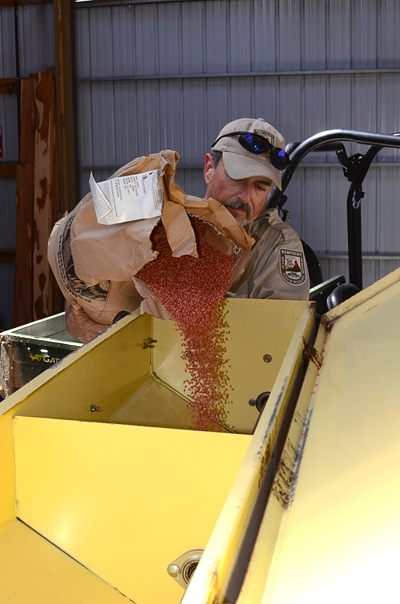By Art Lander Jr.
Frankfort, KY. – The heat of summer is a good time to begin thinking about fall plantings to benefit wildlife.
Winter wheat is a top choice for a fall crop because it is readily eaten by deer and wild turkey and is an excellent nurse crop for clover. Winter wheat is typically planted Aug. 15 through Oct. 31.
Broadcast wheat seed with a hand-crank spreader and rake or disk it under.

“I recommend planting clover at the same time you plant the wheat,” said Joe Lacefield, a private lands wildlife biologist with the Kentucky Department of Fish and Wildlife Resources. “The clover will take root over the winter and come on the next spring as the wheat starts to die back.”
In tobacco country, winter wheat has been the cover crop of choice to the benefit of wildlife. High in protein and easily digestible, winter wheat provides high quality green forage which is especially attractive in the late season.
Lacefield said one way to prepare a site is to mow, then apply herbicide when the re-growth starts.
“After the weeds have died back, then till the area before planting,” said Lacefield. “Ideally, you want to time the planting of your winter wheat and clover seed in anticipation of rain.”
Another site preparation option is tilling or mechanical cultivation whenever the plot is dry over a period of time leading up to planting. Tilling uproots grass and weeds and loosens the soil.
Plots should be located on a level spot with decent soil fertility and full sun a majority of the day.
Winter wheat grows best when the soil has a pH of 5.8 to 6.5. Use a soil test to measure the nutrient levels of nitrogen (N), phosphorus (P), and potassium (K) as well as the acidity of the soil. Soil test kits are available at most farm stores. Follow directions carefully.
If fertilizer needs to be added to your plot, consider using 10-10-10, a formulation commonly available in 50-pound bags. Both fertilizer and agricultural lime are available in pellet form, for easy application with a hand-crank spreader. Lime improves water penetration and the uptake of nutrients of plants growing in acidic soils. Don’t skimp on the amount of lime that is recommended. Low pH is usually an issue with soils in Kentucky.
Two excellent plot locations are the edge of a field or an existing woods opening that deer or turkey are already using. Your tree stand or ground blind should be within easy shooting range and downwind of the plot.
Lacefield suggests planting Ladino or white clover in shaded, woodland openings. Red clover seems to do better in open fields with full sun, growing well on the warm weather days in September and October. Red clover grows taller than white clover and is less impacted by weeds, but all stands of clover need periodic mowing to thrive.
This perennial cool-season legume helps increases soil fertility and provides an almost year-round source of high quality forage for wildlife. An established plot of clover starts growing in the early spring and lasts until it is killed back by the heaviest frosts of late fall.
Author Art Lander Jr. has been writing about the outdoors since the 1970s. He is a staff writer for Kentucky Afield Magazine.
Media Contact: Art lander 1-800-858-1549, ext. 4414


Be the first to comment